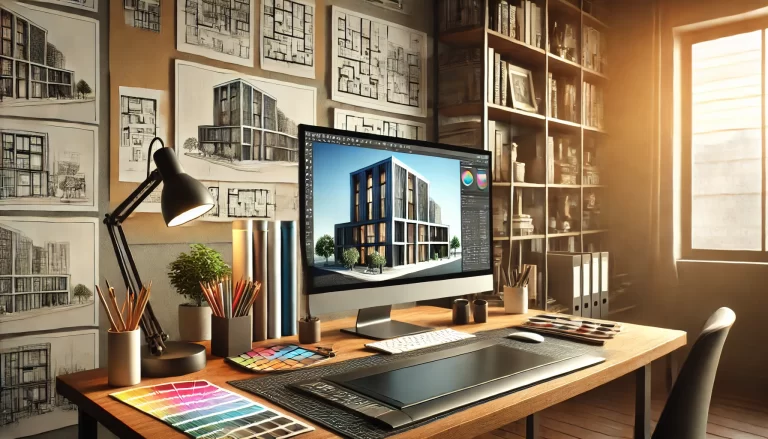What Does It Take to Be a Successful Interior Designer?

Interior design is a dynamic and rewarding career that blends creativity, technical expertise, and business acumen. Whether you’re just starting out or looking to elevate your skills, understanding what it takes to succeed in the industry is crucial. Here’s a comprehensive guide to becoming a successful interior designer.
1. Develop a Strong Foundation in Design Principles
A deep understanding of design principles is essential for creating aesthetically pleasing and functional spaces. Key principles include:
• Balance: Distributing elements evenly for a harmonious look.
• Contrast: Using different colors, textures, and shapes to create visual interest.
• Scale and Proportion: Ensuring furniture and decor fit appropriately within a space.
• Rhythm: Repeating elements to create a sense of movement.
• Emphasis: Highlighting focal points to draw attention.
2. Gain the Necessary Education and Training
While talent is important, formal education can provide the technical knowledge needed to excel.
• Obtain a degree or certification in interior design from an accredited institution.
• Learn about architecture, space planning, and color theory.
• Familiarize yourself with industry-standard software like AutoCAD, SketchUp, and Revit.
• Consider obtaining certifications like NCIDQ (National Council for Interior Design Qualification) to enhance credibility.
3. Build a Strong Portfolio
A compelling portfolio showcases your skills and style, helping you attract clients and job opportunities.
• Include a variety of projects demonstrating your versatility.
• Show before-and-after transformations to highlight your problem-solving abilities.
• Use high-quality images and professional layouts.
• Keep updating your portfolio with new and diverse work.
4. Develop Business and Communication Skills
Interior design isn’t just about creativity; strong business skills are necessary for success.
• Learn project management to handle multiple clients and deadlines efficiently.
• Understand budgeting and cost estimation to ensure financial feasibility.
• Develop excellent communication skills for presenting ideas and working with clients, contractors, and vendors.
• Master negotiation techniques to secure fair deals and contracts.
5. Stay Updated with Industry Trends
Trends in interior design evolve constantly, so staying informed is essential.
• Follow industry magazines like Architectural Digest and Elle Decor.
• Attend design expos and trade shows.
• Participate in workshops and online courses to learn about emerging styles and sustainable practices.
• Engage with design communities and forums to exchange ideas and gain inspiration.
6. Specialize in a Niche Market
Focusing on a particular area of interior design can help you stand out.
• Residential Design: Designing homes and apartments for individuals or families.
• Commercial Design: Creating functional and aesthetically pleasing office, retail, and hospitality spaces.
• Sustainable Design: Incorporating eco-friendly materials and energy-efficient solutions.
• Luxury Design: Catering to high-end clients with bespoke interiors.
• Minimalist Design: Specializing in clean, simple, and functional spaces.
7. Network and Build Professional Relationships
Networking can open doors to new opportunities and collaborations.
• Join professional organizations like ASID (American Society of Interior Designers) or IIDA (International Interior Design Association).
• Connect with architects, contractors, and suppliers for potential partnerships.
• Attend networking events and social gatherings to meet potential clients and industry professionals.
• Utilize social media platforms like Instagram, Pinterest, and LinkedIn to showcase your work and engage with the community.
8. Master the Art of Client Management
Understanding your clients’ needs and expectations is key to success.
• Conduct thorough consultations to grasp their vision and lifestyle requirements.
• Present mood boards and design concepts to align expectations.
• Be transparent about costs, timelines, and potential challenges.
• Maintain professionalism and adaptability when handling feedback and revisions.
9. Enhance Your Technical Skills
In addition to creativity, strong technical skills can set you apart in the industry.
• Learn how to read and create blueprints and floor plans.
• Stay proficient in industry software like AutoCAD, 3D rendering tools, and Photoshop.
• Understand lighting, acoustics, and materials to enhance functionality.
• Gain knowledge of building codes and safety regulations.
10. Be Adaptable and Innovative
Interior design is an ever-changing field, requiring flexibility and innovation.
• Embrace new materials and sustainable practices.
• Experiment with different styles and techniques to expand your skill set.
• Be open to client preferences while maintaining your design integrity.
• Seek inspiration from art, fashion, and global cultures to create unique interiors.
Final Thoughts
Becoming a successful interior designer requires a combination of creativity, technical skills, business knowledge, and interpersonal abilities. By continuously learning, networking, and adapting to industry trends, you can build a thriving career in interior design. Whether you work for a firm or establish your own business, dedication and passion will be your greatest assets in achieving success.






